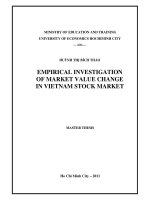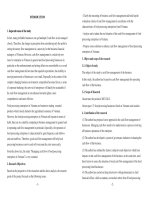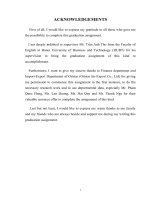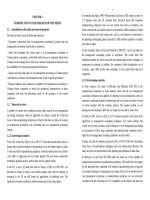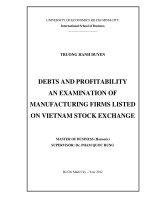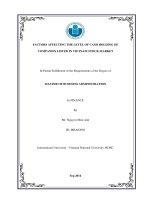Risks on vietnam stock market
Bạn đang xem bản rút gọn của tài liệu. Xem và tải ngay bản đầy đủ của tài liệu tại đây (345.69 KB, 24 trang )
ACADEMY OF BANKING
EVALUATING THE RISKS ASSOCICATED WITH INVESTING IN THE VIETNAMESE
SECURITIES MARKET
Dao Manh Cuong
Student code : 14A7510029
Abstract :
The development of Vietnam stock market (VSM) comes along a lot of risk. This
essay will illustare some types of risk on VSM and proposed solutions to hedge them. I
hope that this study will be helpful in understanding the subject.
Keywords : systematic, unsystematic, market risk, interest rate risk, exchange
rate, risk, inflation risk, legislative risk, business risk, liquidity risk, asymmetric
information, managementảisk, profitability, methods, portfolio, derivatives
I. Introduction
The VSM officially came into operation on 28 July 2000 with only five
listed companies during the year. By the end of 2011, the number of listed
companies had increased to 705. Market capitalization has grown from less
than USD 1 billion to nearly USD 20 billion, with investor accounts rising from
2908 in 2000 to nearly 1.2 million in 2011, among which, around 16 000
accounts are foreign investors and institutions. The stock market has also
contributed considerably to the development of Vietnam with its market
capitalization accounting for 42% of GDP in 2010 as illustrated in Table 1.
However, the market size is still small compared with other regional markets,
implying enormous potential for growth.
Table 1 presents the statistical information about the Vietnamese stock.
Mcap is market capitalization in billion VND; Accounts are the number of
investors’ accounts investing in the Vietnamese stock market; %GDP is the
percentage of Vietnam stock market in GDP; Listed co. is number of listed
companies each year.
Vietnamese stock market, although still characterized by low
capitalization, is one of the world’s rapidly.Vietnam, along with China, India,
Indonesia, Thailand, Philippines and Malaysia will outpace the rest of the world
over the next two years, the International Monetary Fund said in an April report.
Inevitably, along with development, risk is one of the most worrying problems
facing Vietnam today. Moreover, Vietnamese securities market is one of the few
capital markets under the management of a communist government. Thus, there
are many different ways of managing financial markets and politics leading to
specific types of risk in Vietnam.
II. Risk and Market Risk Premium
1. What is risk?
The chance that an investment's actual return will be different than
expected. Risk includes the possibility of losing some or all of the original
investment. Different versions of risk are usually measured by calculating
the standard deviation of the historical returns oraverage returns of a specific
investment. A high standard deviation indicates a high degree of risk.
Risk in stocks investment is the possibility of occuring the unexpected
investing result, or more specifically, is the probability of getting the different
future real profit from the initially expected profitability.
Therefore, all factors changing the originally hoped profitability are considered
risks.
2. Market Risk Premium - offsetting of risks.
Risk is an important component in assessment of the prospects of an
investment. Most investors while making an investment consider less risk as
favorable. The lesser the investment risk, more lucrative is the investment.
However, the thumb rule is the higher the risk, the better the return. The spread
between the average profitability of risky assets and riskless asset is called
“Market Risk Premium” (MRP).
Assuming the statistical average annual profitability for the period (t) of a
some securities on the Vietnamese stock market are as follows:
Securities Average profitability
Common stock 14%
Corporate bond 7%
Government bond 5,5%
Treasury bill 4%
If we consider treasury bill as a riskless asset (risks equal 0) and other
types of securities such as government bond, corporate bond, common stock are
risky assets in different degrees. The risk offseting risks of each type of securities
will be:
Securities Average profitability
Common stock 10%
Corporate bond 3%
Government bond 2,5%
In Vietnam, MPR has been very high (13.3% in 2010). However,
Vietnam market is still not long enough to assess the stability of yields as
well as lack of the representative of market portfolio.
III. Classification of risk on Vietnam securities
market (VSM)
There are many types of risk making the profitability in investment
different from the expectations of investors. However, in securities investment,
we could classified risk into systematic risk and unsystematic risk.
Systematic risk, also known as “undiversifiable risk,” or “volatility”, affects
the overall market, not just a particular stock or industry. This type of risk is
both unpredictable and impossible to completely avoid. It cannot be mitigated
through diversification, only through hedging or by using the right asset
allocation strategy.
Unsystematic risk, also known as “nonsystematic risk,” "specific risk,"
"diversifiable risk" or "residual risk," is the risk of price change due to the unique
circumstances of a specific security, as opposed to the overall market. This risk
can be virtually eliminated from a portfolio through diversification. By owning
stocks in different companies and in different industries, as well as by owning
other types of securities such as Treasuries and municipal securities, investors
will be less affected by an event or decision that has a strong impact on one
company, industry or investment type.
We will look at those types of risk on Vietnamese securities market.
1. Systematic risk
a. Market risk.
Stocks price can fluctuate significantly in a short time , even though the
company's income do not change . There are many different cause for this,
however, it mainly depends on the investors’ perception for stocks in general , or
for a particular group of stocks . The changes in profitability of most stocks,
which is mainly due to the conversion of investors’ expectation, is called market
risk .
Market risk occurs because of the reaction of investors to the tangible events
such as the economic, political , social cases or intangible events or intangible
events that arise by dint of the psychological factors of market.
In Vietnam , a typical example is the case when the European debt crisis
began breaking out in 2010. From July to August 2010 , two Vietnam stocks
indexes hit the lowest point of the year . In two months , VN - Index dropped by
more than 16% . In 2011, moreover, VN-Index bottomed five consecutive times.
Mr. Le Ba Hoang Quang , the expert of Sacombank said that : “The direct
impacts of the European debt crisis on VSM were not really marked . The
variation that we have seen in recent sessions were as a result of the
psychological factors and outrageous reactions."
In addition, Vietnamese investors are still heavily influenced by “herd
mentality”. They are excitable by the market , sold at low prices and buy at high
prices, leading to the high risks .
b. Interest rate risk
In theory, the interest rates and the stock sprice have a negative
correlation because of some following reasons :
Firstly, lower interest rate will make the savings channel become less
attractive, therefore cash flow turns to other channels to find the higher
incomes.
Next, a rise in the interest rate reduces the present value of future
dividend’s income, which should depress stocks prices.
Conversely, low interest rates result in a lower opportunity cost of
borrowing. Lower interest rates stimulate investments and economic activities,
which would cause prices to rise.
VSM has seen many
other cases following this
rule. Recently, from 10 -
03/14/2014, VN-Index
went up again by 2.95%
to 596.83 points, the
HNX-Index also increased
by 2.76% to 84.43 points,
while the VS 100 showed
an growth of 3.39% to
99.01 points,
immediately after the
State Bank decided to
reduce the interest rate
ceiling.
However, because of the natures of a nascent
market, in many cases, the lower interest rates did
not make positive effects on the VSM. For
example, in June 2012, after being successful in
stimulating the stock market in the last two
months, the reductions in interest rate lead to a
fall by 1.76% of VN-Index and 2, 31% of HNX-
Index. Trading value on HSX only was around 700
billion/day, and almost $ 300 billion/day on HNX.
This is because many stock companies and
investors simultaneously think that VSM was not
strong enough to establish a upward trend and
the expected return was not commensurate with
risk. Brokers
also advised the investors to limit their disbursement during this period.
This leads to the very low liquidity on VSM.
In addition, in the context of banking reform, the change of interest rate
will be very difficult to predict, thereby it creats the unforeseen modifications on
VSM. Interest rate impacts on price on the whole market and because
individuals and organizations are not able to decide the interest rate, so it is
almost impossible to avoid this kind of risk. Therefore, interest rate risk is
considered to be a systematic risk.
c. Exchange rate risk
Exchange-rate risk is the risk that investors face when they buy and hold
investments in a currency other than their native currency. Currency prices
fluctuate up and down just as shares do. If the currency in which the investment
is held gains value compared to the investor’s native currency, the investment
will be worth more to the investor. However, if the currency in which the
investment is held loses value compared to the investor’s native currency, the
investment will be worth less to the investor. Exchange-rate risk can even offset
any gains the investment may have made on its own.
The Vietnam Dong (VND) exchange rate is unstable. For instance, in 2011,
the VND slumped to as weak as 20,893 per dollar, compared with 19,498 only in
one day, the most devaluation since at least 1993. It seems to be risky for both
investors and firms.
For investors , exchange rate is mainly concerned about by
institutional or foreign investors. In theory, the exchange rate risk is
due to the impact of exchange rates on the investments . When
investors think that the currency may devaluated in the future, they
will decide not to invest in that country’s market because of the
reduction in securities value. When investors invest in the Vietnamese
market , however, they are forced to use VND. Meanwhile , the VND
exchange rate against other major currencies , such as USD/VND ,
EUR/VND , JYP /VND often tend to decrease. Therefore, if foreign
investors really appreciate the potential of VSM, they will still fund
foreign currency to convert to VND . The problem is that when the
liquidity and dividends are swollen, the profitability of securities
investments will not be enough to offset the devaluation of the
exchange . Hence, the effects of exchange rate risk on investors is not
marked.
For firms, according to an official from the State Bank of Vietnam, the
strong exchange rate change policy may lead to unforeseeable risks.
Many Vietnamese enterprises borrowed USD from domestic and
international banks. If their main incomes are in VND and they have to
settle debts in USD, their profits will reduce in the event of higher
USD/VND exchange rate. Even, some may be unable to settle debts;
therefore, this greatly affect on the liquidity of that company’s stock. In
fact, many companies reported in their financial statements in 2008
that their business results were seriously affected by the exchange rate
risks.
The typical example of foreign exchange risk is Pha Lai Power Joint
Stock Company. The power generator borrowed in Japanese yen. It had
to incur double exchange rate risks: one is the depreciation of VND
against USD and the appreciation of yen against USD. At that time, the
shares in Pha Lai Power Joint Stock Company were put under special
surveillance of market authorities because they suffered losses in 2008.
d. Inflation risk.
Inflation risk is also known as Purchasing Power Risk, this risk arises from
the decline in value of securities cash flow due to inflation, which is measured
in terms of purchasing power.
The research shows that in all five-year periods between 1991 and 2012,
Vietnam outpaced all other regional nations in only one aspect: inflation.
Inflation in Vietnam was over 18% in 2011 and 6.8% in 2012, far higher
than the average 3% of China, Indonesia, the Philippines and Thailand.
Indonesia had the highest inflation among these nations, 3.8-5% in the last
two years, still lower than the rate in Vietnam. From 1986 to 2012, there
were 13 years and four five-year periods in which inflation in Vietnam stayed
at a double-digit level or above. Notably, the average inflation rate in
Vietnam was 225% in the 1986-1992 period, 16.3% in 2007-2008 and 15%
in 2010-2011. In the period from 2008 to 2012, Vietnam recorded an average
economic growth of 5.9% per year and inflation of 12.6%, while the
respective figures in China were 9.3% and 3.3%.
Table 4 shows the relationship between the inflation and Vietnam stock.
As we can see, 2007 saw the notable improvement of VN-Index when CPI had
been controlled. Vice versa, from 2008 to 2009,the inflation reached the
highest level, making the index fell sharply.
The Price Management Department under the Ministry of Finance has
forecast that there still are risks for Vietnam’s inflation to be high in 2014
due to the impact of policies to remove difficulties for business and
production in 2013. According to Dr. Vu Dinh Anh, in 2014, prices and market
will also be impacted by loosening policies such as the widening of budget
deficit to 5.3 percent of GDP and the issuance of bonds worth 170 trillion
VND (8 billion USD) for the 2011-2015 period.
Moreover, high inflation is the risk that raise the interest rate (i = i
r
+ π
e
) ,
leads to the stock devaluation, as stated above.
e. Legislative risk.
This risk is inevitable for all new formed stock market. The government
can issue different types of policies affecting directly to investors. This may
cause investors can not implement the investing strategies that could have
been done. Especially, when the policy suddenly changes, investors may be
stuck, even be illegal if they can not catch up with the policy change.
On 27/9/2010, Circular no. 19/2010/TT-NHNN amending Circular no.
13/2010/TT-NHNN defining the prudential ratios of credit system was
enacted. Circular No. 13 and Circular 19 is the legal documents which is
considered to be the biggest effect on VSM in 2010 because of the possibility
of massive divestment of banks. This could reduce the lending activities for
investments in securities, real estate, to ensure the capital adequacy under
the new standard.
2. Unsystematic risk.
a. Business risk.
The possibility that a company will have lower than anticipated profits, or
that it will experience a loss rather than a profit. Business risk is influenced by
numerous factors, including sales volume, per-unit price, input costs,
competition, overall economic climate and government regulations. A company
with a higher business risk should choose a capital structure that has a lower
debt ratio to ensure that it can meet its financial obligations at all times.
In Vietnam, there are many factors that lead to the busniness
environmental risks of firms, the following can be mentioned:
Goods and services supply/demand
In 2006, Vietnam joined the WTO; however, goods and services market is
seem to be more unstable. This has brought many risks for businesses with the
adverse shifts in supply and demand of their goods and services.
For example, in 10 months of 2012, Vinacomin produced 36.7 million tons
of coal being equivalent to 34.5 million tons of clean coal.
However, on account of the low domestic purchasing power, especially for
household electricity, cement, fertilizer, chemicals and building materials , coal
consumption was estimated at 30.7 million tons, equals 67.6% of the plan and
84.4% compared to the same period in 2011. This brought on the fact that in
3,000 billion bonds released in July 2012 of this company, the rate on successful
bond sale was only 17% of the offered. Coupon rate was only 14,5% for the first
year.
Labor force
Generally speaking, labor costs in Vietnam are low and competitive in
attracting the foreign investment. But the negative side is that strikes should
happen if wage rates are too low. Besides, the quality of labor is a challenge
facing Vietnam. Due to the weakness of the educational and training system, the
economy has been not provided with good skilled labors and managers. During
the last three decades, Vietnamese government launched many programs to
reform the education and training. Despite of these efforts, no significant
performances in this area have been recorded. The key reason of this failure,
from my viewpoint, is the problem of the ideology, which really hinders the
international integration of Vietnam in the field of education and training.
Taxes and other expenses
Vietnam has improved considerably as a site for investment. However, it
cannot compete fully with either BOI Zone 3 in Thailand or with most areas in
China, but it has considerably narrowed the difference and should not be
dismissed outright in any case. Land ownership or more accurately land lease as
that is all that the Vietnam law currently allows is still significantly less
advantageous when compared to Thailand and even to China. Utilities are still
high when compared to other sites like China or Thailand in the region. Vietnam
has recently reduced telephone charges but more is needed in not only this area
but in other utility charges as well. Taxes and fees are still too high. Supporting
industries are still weak. Recent investments in plastic and other industries
should remedy this in time in the plastics field but for now, this continues to be a
weakness.
Transparency
Transparency have been improved in recent years under pressure of
Vietnam’s commitments with international bodies and organizations. Legal
documents and official government decisions now are freely available and
directly accessible to the public, for example through internet. However,
transparency is still one of the important weaknesses of the governance in
Vietnam. In reality, there are dark areas the public is not easy to access or is not
provided with clear and enough information.
b. Liquidity risk
The risk stemming from the lack of marketability of an investment that
cannot be bought or sold quickly enough to prevent or minimize a loss. Liquidity
risk is typically reflected in unusually wide bid-ask spreads or large price
movements (especially to the downside). The rule of thumb is that the smaller
the size of the security or its issuer, the larger the liquidity risk.
The main cause of liquidity risk is the imbalance among revenues,
expenses and debts of the firm, resulting the default in coupon payments and
dividends for the share holder. This type of risk is due to internal factors of the
company and can be controlled. For this reason, it is considered as a
unsystematic risk.
There is a close relationship between P/E ratio and stocks liquidity. Other
things being equal, stocks which are highly liquid command higher P / E
multiples and stocks which are highly illiquid command lower P / E multiples.
The reason for this is not far to seek. Investos value liquidity just the way they
value safety and hence are willing to give higher P /E multiples to liquid sotcks.
Therefore, we can evaluate the stocks liquidity partly through the P / E.
As can be seen in table 3 (section e part 1), the P / E enjoied a downward
trend from 2006 to 2012, meant that the liquidity declined. In 2011, On the HCM
City Stock Exchange on Friday, the VN-Index closed at 377.16 points, a decline of
1.75 per cent from the previous week's close. Meanwhile, on the Ha Noi Stock
Exchange, shares edged up slightly over the course of the week, with the HNX-
Index closing on Friday at 61.73 points, a gain of 0:08 per cent on the week. Blue
chips on both exchanges lost an average of 1.8 per cent of their value, while
penny stocks declined by a less dramatic 1.2 per cent overall. Mid-caps largely
tread water. Shares of other small securities companies were also strongly
affected by rocketing sell pressures. Analysts said that liquidity risks represented
by these companies had become systematic and that the market would continue
to be adversely affected.
In August 2011, margin trading was officially recognized in VSM. Then,
margin trading has been used a lot. Indexes’s motivation almost has been price
rather than cash flows, resulting the risks for not only stock companies but also
the whole market.
In 2013, the stocks liquidity , however, has improved. The extension of
trading hours and trading band, applying the market orders and adjusting the
margin rate from 40/60 to 50/50 (however, this rate could be double-edged)
boosted the liquidity. The average transaction size per session reached 2.578
billion, jumped by 31% when compared with 2012, however, mainly by
government bond trading (1,257 billion VND/session, surged by 90%). The
market maker systems on both the primary market and the secondary market
were formed; 36 market members were recognized. Therefore, the liquidity in
2014 is considered to be quite satisfactory.
c. Asymmetric information
A situation in which one party in a transaction has more or superior
information compared to another. This often happens in transactions where the
seller knows more than the buyer, although the reverse can happen as well.
Potentially, this could be a harmful situation because one party can take
advantage of the other party's lack of knowledge.
The most common violation in asymmetric information is persons in the
board of directors or with relationship with members of the board of directors
do not announce transaction plans and information as required by the laws. The
Hochiminh Stock Exchange (HOSE) has named a dozen of major shareholders,
insiders and affiliated persons for not informing of their transactions. Notorious
companies with such a violation included MKP, PXT, DQC, CMT, SJS , LAF and ELC.
On the Hanoi Stock Exchange (HNX), companies with information violators
include AGC, SHN, THV and S74.
Typically, Mekophar Chemical Pharmaceutical Joint Stock Company (MKP)
bought back its shares for treasury shares from February 3, 2012 to March 12,
2012 with illegitimate volumes and values regulated by the laws. Mr Nguyen
Bac Son, member of the Supervisory Board of Dien Quang Joint Stock Company
(DQC) - a lamp producer - sold 51,000 DQC shares from December 20, 2011 to on
February 6, 2012 without providing statutory information disclosure. Besides, he
reported share transaction results behind time.
These violations cause substantial damage to investors, distort and mislead
the market. Although the authorities have taken stronger hands with such
violations, the effect is too minor to damage.
d. Management Risk
The risks associated with ineffective, destructive or underperforming
management, which hurts shareholders and the company or fund being
managed. This term refers to the risk of the situation in which the company and
shareholders would have been better off without the choices made by
management.
We will consider this risk with two types of business in Vietnam :
State Owned Enterprises
Currently, there are above 10 state economic groups in Vietnam. State
economic groups as well as other state corporations have been favored by
government in getting funds from government budget or state banks. The
government still guaranteed their borrowing funds from international market.
This kind of subsidy or support in reality have negative effect on their business
operation and as a source of corruption. The large amount of funds have been
used wastefully because, firstly, managers have no engine to use effectively these
public funds. State companies have worked at very low efficiency. In 2009, 40.6%
of the total investment funds fell into the state sector , but it produced only
35.13% of GDP (GSO). In reality, the establishment of state companies generally
and state economic groups specially are mainly through bureaucratic measures,
and have been not driven by the market force, such as through mergence, sell or
buy of companies. An important shortcoming of state enterprises is that 12 their
manpower, especially their managers have been not well trained. Therefore, the
management of a too large firm is beyond their ability. In addition, state
enterprises are a fat land where interest groups can extend their influences.
VINASHIN (Vietnam Ship Industry Group) is a state company which
became a state economic group in 2006. This company has been hoped to
become one leading state group and it was the most favored state company. In
2005, Vietnamese government issued US$750 bonds in the international
financial market to finance VINASHIN.
Moreover, VINASHIN still borrowed at least US$600 millions from foreign
banks. This company also got a huge amount of funds, especially credits from
state banks, as it required. But, due to the bad management with many crazy
investment projects and corruption, in June 2010, its total debt was at least
VND86,000 billions (equivalent to US$4.6 billions), which were equal to 83% of
its total assets (Nguyen Tan Dung, November 2010, p. 7). To save VINASHIN, the
government continues pumping money into it. The case of VINASHIN can be seen
as a signal of the collapse of the leading role of state enterprises.
VINASHIN may issue new bonds guaranteed by the Government in order
to repay domestic lenders and bond holders. This would function as a swap with
all existing debt-holders able to participate. The total amount of Vinashin bonds
outstanding comes to around VND8,300 billion. Then guessing the amount of
domestic Vinashin debt outstanding on top of that is a bit of an art. However in
our banking report published last year we guesstimated it at VND45,715 trillion.
Private sector
The private sector in Vietnam, has a short history, therefore its
businessmen are nowadays in the phase of the exercise of doing business,
with low management skills and having no long-term strategy. Their
business enthusiasm is still impeded by the low confidence in the government
policy on the protection of the property rights, as the consequence of the past
policy on the private sector as well as the current policy on “a market
economy with socialist orientation”. The property rights index is reported by
the Heritage Foundation and the Wall Street Journal as a subcomponent of
the Index of Economic Freedom. In their 2010 Report, Vietnam got the score
of 15, compared to 90 of Hong Kong, 90 of Singapore and 80 of Japan (the
higher scores the more desirable with the range from 0 to 100)
In conclusion, bad management and the lack of an efficient mechanism to
supervise are leading to the risks of losses and reducing the value of
securities in Vietnam.
IV. The relationship between profitability and
risk on VSM through some important
milestones.
Profitability = Interest + Capital (Principal) gain
Profitability Ratios : Rn =
Po
DIVPoPn
n
t
t
∑
=
+−
0
)(
The expected profitability of a financial asset is directly
proportional to the systematic risk, measured by beta of the
asset : E(R
i
) = R
f
+ β( E(R
m
) – Rf)
This is a tool to calculate securities being considered to invest if the
profitability commensurate with the risk.
The relationship between profitability and risk on VSM through some
important milestones.
Period Profitability
Ratios (%/month)
Level of risk
(%/month)
Comments
Before 10/2001 6.56 17.182 Market begined
operating, both
two ratios were
high.
2002 - 2004 0.347 8.299
2005 - 2007 5.241 12.681 The average
profitability
was five times
higher than it
of the world.
This is the
boom period of
VSM.
2007 1.05 4,3
2008 -4,25 10,6 The period
when VSM
affected by the
world crisis
2009 -1,03 27
V. Some risk management methods on VSM.
1. Diversifying invetsment portfolio
Probably the worst mistake a new investor can make is to not properly
diversify their portfolio. Simply put, it is foolish to invest all money in one
investment. It may be tempting to invest your life savings in a "hot stock tip", but
one of these hot tips may burn up your entire net worth. In short, diversify.
Allocating securities widely hedges against the risk that certain securities
classes will perform well while others perform poorly. For example, if many
investors begin buying corporate stocks, stock prices will rise; however, those
investors may be selling bonds to fund their stock purchases, causing bond prices
to fall. Spreading investments between stocks and bonds will protect against the
risk of either category performing poorly.
Whit managing the risk of each trade your portfolio risk will be well under
control and you manage your portfolio risk actively, but to control your portfolio
risk management better notice to this pointes:
1- Determine your overall cut-loss level. Usually your portfolio should not
lose more than 10% of your capital.
2- Diversify your investment in at least six or more different stocks.
3- Know your overall risk tolerance before building up the portfolio.
4- Act quickly when you see your risk limits exceeded.
5- Close out the entire portfolio if it loses to your overall stop-loss level.
Diversification is not simply spreading your money around into different
stocks; you have to diversify your investment funds into different types of stocks.
Another way to reduce the risk is investing abroad.
The results indicate that investing only in the domestic market can let
investors exposed to the very high level of risk. Therefore, internationally
diversified portfolio had more diversification value than a domestically
diversifiedportfolio in terms of risk for Vietnamese investor.
2. Using derivatives
Derivatives are Securities whose value stems or is derived from the value
of other assets. Swaps, options, and futures are used to manage financial risk
exposures. Early, the VSM is preparing to leverage exchange traded funds (ETFs)
and would-be derivatives to lure more capital, heard a workshop in Ho Chi Minh
City March 25.
Regulators are speeding up legal and technical preparations so that the
first ETFs could start operations in the second quarter of this year, said Nguyen
Son, head of market development department under the State Securities
Commission. ETFs are funds that track specific indexes and whose portfolios
include a basket of stocks. To date, all operating funds in Vietnam are closed-end
funds.
The Ho Chi Minh Stock Exchange (HOSE) and Hanoi Exchange (HNX) are
finishing rules for product design and trading mechanism of ETF fund
certificates. The Vietnam Securities Depository is completing a project that
allows clearing of ETF products and deals with risks related to ETF transaction
cancellation.
After all the steps are finished and piloted at stock exchanges, the first
ETFs will be launched into transaction.
3. Reducing asymmetric information :
For investors :
• Getting away from the penny stocks which lack of information because
that stocks are vulnerable to be frauded and manipulated.
• Completing their analysis techniques, avoid the herd mentality.
For regulators :
• Developing and improving the securities legislation and intensified law
enforcement.
• Establishing and improving the supervision of the organization of the
securities markets.
• Improving the listed companies to disclose information systems, and
strengthening the supervision of insider.
• Improving the corporate governance structure of listed companies.
• Strengthening the supervision of securities intermediaries.
In conclusion, Vietnam stock market has achieved the considerable
development, however, there have been a lot of potential risks. Investors should
always consider carefully before making decision, and look forward to the sound
leadership of regulators.
References :
- “Risks and statistical analysis of risk”, (in Vietnamese), available at
/>- “Which Standards for Risk Management on Vietnam Stock Market”, Stockbiz,
available at />for-risk-management-on-vietnam-stock-market.aspx.
- Ji Wu (Xiamen University), Cuong Nguyen (Lincoln University) , Andros Gregoriou
(University of Hull) , “Systematic Risk, Idiosyncratic Risk, and Asset Pricing Models:
Empirical Evidence from the Vietnamese Stock Market”.
- “Investors Suffer from Disadvantages of Unclear Information”, Vietnam Business
Forum, available at />- “Market risk premium - RMP”, (in Vietnamese),, available at
/>%A7i-ro-th%E1%BB%8B-tr%C6%B0%E1%BB%9Dng-%E2%80%93-mrp-vn-kho
%E1%BA%A3ng-133/
- Nguyen Nhu Binh (December 2010), “The Recent Economic Situation of Vietnam
and Investment Risks”, Center for Risk Research, Faculty of Economics, SHIGA
UNIVERSITY.
- “Vietnam pushing stock market with ETFs, future derivatives”, Stockbiz, available
at />market-with-etfs-future-derivatives.aspx
- “Monthly Deposit and Lending rate”, SBV Monthly Reports and Other sources
(indicated if any).
- “The Vietnam Stock Market Report 03-22-2012”, VietnamReport, available at
/>- YANG Jing, “Causes and Solutions of Information Asymmetry in Stock Market”,
School of KeXin Hebei University of Engineering, P.R.China 056038.
